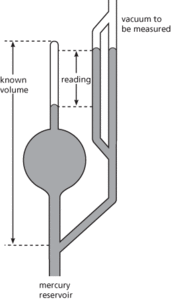A vacuum pressure gauge in which a relatively large volume of a low-pressure gas is compressed to a small volume in a glass apparatus. The volume is reduced to an extent that causes the pressure to rise sufficiently to support a column of fluid high enough to read. This simple device, which relies on Boyle’s law, is suitable for measuring pressures in the range 103 to 10−3 pascal. It is named after Herbert McLeod (1841–1923), who invented it in 1874.

McLeod gauge.
A vacuum pressure gauge, devised by Herbert McLeod (1841–1923) in 1874, in which a relatively large volume of a low-pressure gas is compressed to a small volume in a glass apparatus. The volume is reduced to an extent that causes the pressure to rise sufficiently to support a column of fluid high enough to read. This simple device, which relies on Boyle’s law, is suitable for measuring pressures in the range 103 to 10−3 pascal.
- Schmidt, Maarten (1929–)
- Schmidt net
- Schmidt number
- Schmidt–Cassegrain telescope
- Schmidt–Lambert net
- Schmitt, Carl (1888–1985)
- Schmitt, Harrison Hagan (1935– )
- Schmitt trigger
- Schoenberg–Chandrasekhar limit
- Schoenflies system
- scholasticism
- Schonhage algorithm
- Schonhage–Strassen algorithm
- Schopenhauer, Arthur (1788–1860)
- schorl
- Schottky barrier
- Schottky clamp
- Schottky defect
- Schottky diode
- Schottky effect
- Schottky-gate field-effect transistor
- Schottky I2L
- Schottky noise
- Schottky photodiode
- Schottky TTL